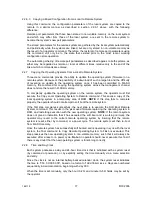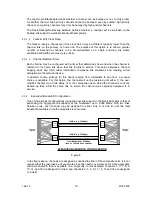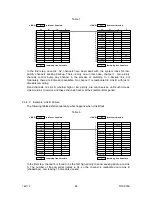
166119
8/31/2006
15
bandwidth is added to carry the control signal end-to-end. While bandwidth is added in both
directions, only the port selected to respond to the RTS from the opposite end of the channel
will operate in this mode. If this option is changed while the channel is allocated, there will be
a momentary disruption of the channel data as the system re-configures the channel.
For port parameters, local and remote ports must be configured separately. However, both
local and remote ports may be configured in the same session from either end of the
multiplexer link.
NOTE:
Two unlinked systems, whose channels have been configured with identical
parameters in separate sessions, may not pass end-to-end channel data correctly when they
are subsequently linked. Without coordinating the channel allocation sequence between
linked systems via the management channel, multiplexer frame maps are not likely to match.
2.2.2 Non-volatile Parameter Storage
Operating configuration parameters for the Nx8-DualMUX that are modified by the user are
first written in random-access-memory (RAM). As long as the power is not turned off or the
mux is not reset, the system will continue to work with these parameters in effect. This is
referred to as the “working configuration”.
When the user is satisfied with the working configuration parameters as they are set, or
simply wishes to save the working configuration for a later editing session, that configuration
may be stored in non-volatile (FLASH) memory. Once saved, the same configuration will be
restored to RAM each time the power is turned on or a system reset occurs. This
configuration is called the “stored configuration”.
One exception to the preceding paragraph occurs in the case of channel loopback functions.
Both local and remote channel loops when put into effect by the user via a menu option, are
immediately stored in FLASH memory. Therefore, it is not necessary to save a channel
loopback state to preserve it‟s status in the event of a power loss to the system.
Other commands available to the user also result in storing the working configuration to
FLASH memory. These include the commands “Copy Configuration to Remote”, “Enter Node
ID”, and modifying the Composite Link Rate. In most cases, the storing of configuration
information is synchronized on both Local and Remote systems, via the management
channel.
A diagram illustrating the operations which result in changes to the working and stored
configurations and the effect on both local and remote systems may be found in Appendix
section
Error! Reference source not found.
-
Error! Reference source not found.
.
2.2.3 Null Configuration Reset
A working configuration may be erased and returned to a default non-functional condition
through a null configuration reset. This operation de-allocates all channels, resets all channel
ports to a standard default condition, and disables the composite port on the local system.
This operation does not erase the configuration stored in FLASH memory
NOTE:
The null configuration reset operation affects only the LOCAL system. Thus channels
that are allocated on the remote system will appear unallocated on the local system. This
command should only be used as a last resort in order to re-initialize a configuration that
cannot be easily rectified. In most cases, this operation should be performed on both local
and remote systems before proceeding to build a new configuration.
Содержание Nx8- Dual Composite MUX High-Speed 16-Port TDM Multiplexer
Страница 2: ......
Страница 6: ...166119 8 31 2006 2...
Страница 32: ...166119 8 31 2006 28...
Страница 38: ...166119 8 31 2006 34...
Страница 61: ...166119 8 31 2006 57...
Страница 62: ...166119 8 31 2006 58...
















































